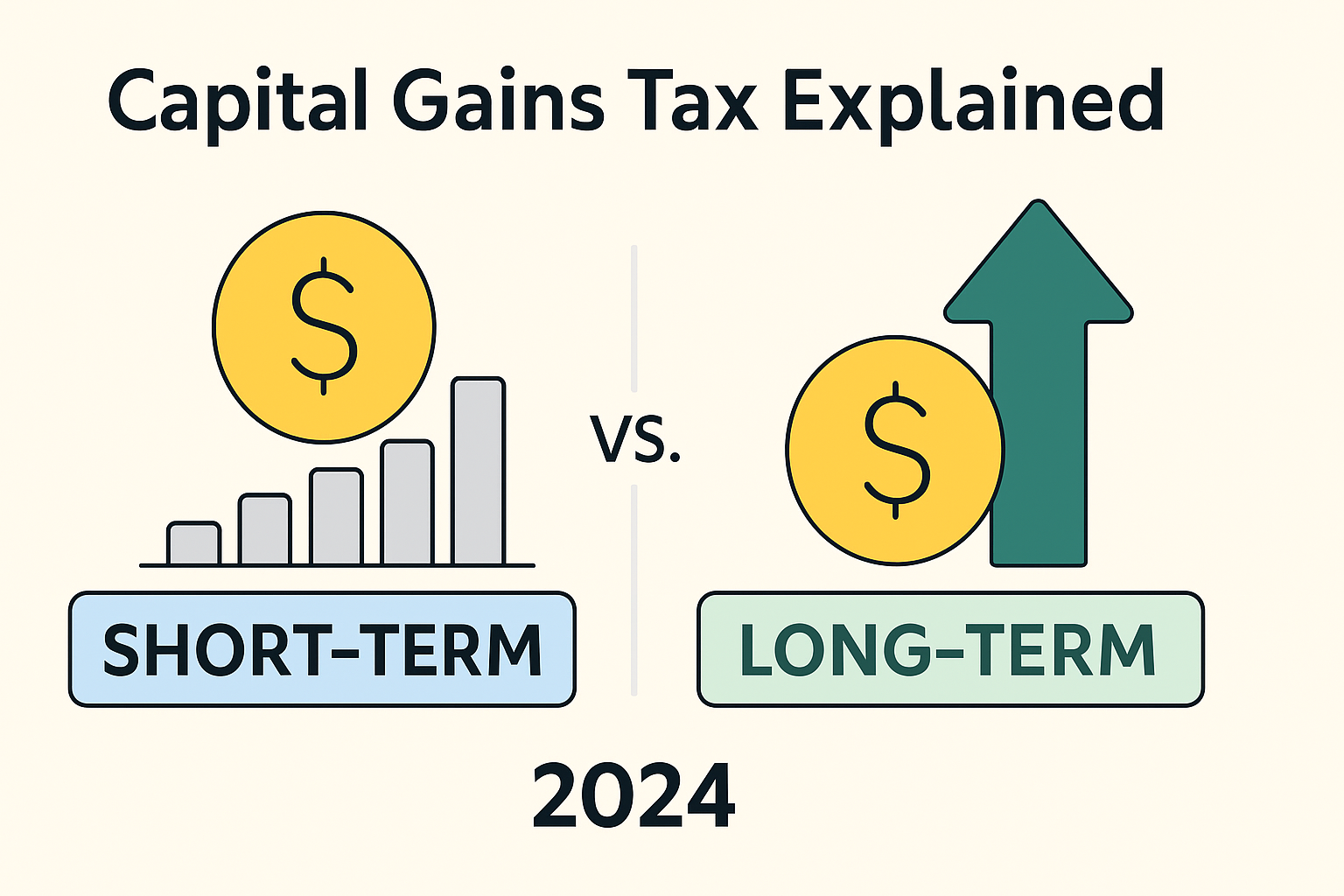
Understanding how capital gains tax works is essential for investors, business owners, and anyone looking to maximize after-tax returns. In 2024, the distinction between short-term capital gains and long-term capital gains can mean thousands of dollars in tax savings—or liabilities—depending on your investment horizon and income level. This comprehensive guide breaks down everything you need to know about capital gains tax rates, strategies to optimize your tax position, and actionable advice to keep more of your hard-earned money.
1. What Are Capital Gains?
A capital gain is the profit realized when you sell an asset for more than your "basis" (usually, the purchase price plus transaction costs). Common assets include:
- Stocks and bonds
- Real estate (excluding primary residence exemptions)
- Business interests
- Collectibles (art, antiques)
Conversely, if you sell an asset for less than your basis, you incur a capital loss, which can offset gains and reduce taxable income (up to certain limits) .
2. Short-Term vs. Long-Term Capital Gains
Short-Term Capital Gains
- Held for One Year or Less: When you sell an asset within 12 months of acquisition.
- Taxed as Ordinary Income: Your short-term gains are added to your taxable income and taxed at your marginal federal income tax rate, which in 2024 ranges from 10% to 37% .
Long-Term Capital Gains
- Held for More Than One Year: Assets sold after at least a 12-month holding period qualify.
- Preferential Tax Rates: Long-term gains benefit from lower federal rates—0%, 15%, or 20%—depending on your taxable income and filing status .
Understanding the difference is crucial: on a $100,000 gain, being taxed at 15% instead of 37% saves $22,000 in federal taxes alone.
3. 2024 Federal Capital Gains Tax Rates
The IRS updates tax brackets annually. Here are the 2024 long-term capital gains rates by filing status (married filing jointly, single, head of household):
|
Tax Rate |
Married Filing Jointly |
Single Filers |
Head of Household |
|
0% |
Up to $89,250 |
Up to $44,625 |
Up to $59,750 |
|
15% |
$89,251 – $553,850 |
$44,626 – $492,300 |
$59,751 – $523,050 |
|
20% |
Over $553,850 |
Over $492,300 |
Over $523,050 |
Short-term gains are taxed at ordinary rates (10%–37%) based on the 2024 federal income tax brackets .
4. How Capital Gains Tax Rates Are Determined
Several factors influence your effective capital gains tax rate:
- Holding Period
- ≤1 year: ordinary rates
- 1 year: preferential rates
- ≤1 year: ordinary rates
- Taxable Income
- Determines 0%, 15%, or 20% for long-term gains
- Determines 0%, 15%, or 20% for long-term gains
- Net Investment Income Tax (NIIT)
- Additional 3.8% on investment income (including gains) for high earners (>$250k MFJ, >$200k single) .
- Additional 3.8% on investment income (including gains) for high earners (>$250k MFJ, >$200k single) .
- State Taxes
- Some states tax capital gains as ordinary income, adding up to 13.3% (California) .
- Some states tax capital gains as ordinary income, adding up to 13.3% (California) .
5. Strategies to Minimize Capital Gains Taxes
A. Hold for the Long Term
Whenever feasible, extend your holding period beyond 12 months to access lower long-term rates.
B. Tax-Loss Harvesting
Offset gains by selling underperforming investments at a loss. Net capital losses up to $3,000/year can offset ordinary income; excess can carry forward .
C. Utilize Tax-Advantaged Accounts
- 401(k), IRA, Roth IRA: Investments grow tax-deferred or tax-free.
- Health Savings Accounts (HSA): Triple tax benefit on contributions, growth, and distributions.
D. Gift or Donate Appreciated Assets
- Gifting: Transfer assets to family members in lower brackets; they assume your cost basis.
- Charitable Donations: Donate appreciated stock to avoid capital gains and take a charitable deduction .
E. 1031 Exchanges (Real Estate)
Defer gains on real estate by swapping like-kind properties under Section 1031 rules .
6. Special Considerations & Exceptions
- Primary Residence Exclusion: Up to $250k (single) or $500k (married) of gain on a home sale may be excluded if owned and lived in 2 of the last 5 years .
- Small Business Stock: Section 1202 may exclude up to 100% of gain on QSBS if held >5 years.
- Inherited Assets: Receive a “step-up” in basis, often eliminating gains at inheritance.
7. State Capital Gains Taxes
State treatment varies:
- No State Income Tax: FL, TX, WA—no state capital gains tax.
- Flat-Rate States: PA (3.07%), IL (4.95%).
- Bracketed States: CA up to 13.3%, NY up to 10.9% .
Always consult your state’s Department of Revenue for the latest rates.
8. Common Misconceptions
- “All Gains Are Taxed Equally”
- Short-term vs. long-term differences matter greatly.
- Short-term vs. long-term differences matter greatly.
- “I Can Defer Gains Forever”
- 1031 exchanges apply only to real estate; others generally trigger tax.
- 1031 exchanges apply only to real estate; others generally trigger tax.
- “I Don’t Need to Worry About Small Gains”
- Frequent small trades can accumulate significant tax liabilities.
- Frequent small trades can accumulate significant tax liabilities.
9. Actionable Takeaways
- Plan Holding Periods: Aim for >1 year to access lower rates.
- Harvest Losses: Offset gains annually via tax-loss harvesting.
- Use Tax-Advantaged Vehicles: Maximize IRAs, 401(k)s, HSAs.
- Explore Exclusions: Primary residence and small business stock can shelter gains.
- Consult a Tax Professional: Complex strategies warrant expert guidance.
10. Call to Action
Navigating capital gains tax can be complex, but with careful planning, you can significantly reduce your tax burden. If you’d like personalized guidance, please schedule a call with the BetterWealth team. Our advisors specialize in tax-efficient investment strategies and can help you optimize your portfolio for 2024 and beyond.
References:
- IRS, “Topic No. 409 Capital Gains and Losses,” irs.gov
- IRS, “Net Investment Income Tax,” irs.gov
- IRS, “Sale of Your Home,” irs.gov





